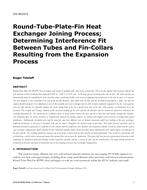Click here to purchase
Round-Tube-Plate-Fin (RTPF) heat exchanger coils consist of multiple tubes and stacks of plate fins. These are put together with clearance between the tube diameter and the inside fin-hole, typically 0.010 in. – 0.015 in. (0.25 mm – 0.38 mm), for ease of lacing tubes into the fins. The tubes and fins are mechanically joined by expanding the tubes by either using a mechanical bullet or by means of applying internal pressure to the tube to cause it to expand. The tube diameter is first expanded to the size of the fin-hole diameter, after which both the tube and fin are further expanded to a larger size than the original fin-hole diameter. It is important to note in the assembly of a heat exchanger that the tube is fairly malleable compared to the fin. Consequently, when the tube and fin are expanded together, the elastic spring-back of the fin is greater than that of the tube. This generates an interference fit in the assembly. The strength and Young’s modulus of the materials making up the tube and fin, the diameter and the amount of expansion, determines the resulting interference fit. The interference fit establishes metal to metal contact between the tube and fin so that heat will conduct through this interface. The insulating effect of surface curvature or imperfections between the mating surfaces are reduced with higher contact pressure resulting from greater interference. Additionally, dissimilar tube and fin materials may have different rates of thermal expansion under heat loading of the heat exchanger. Sufficient interference is necessary to maintain tube and fin contact throughout the thermal range of operation. This paper presents equations used to determine interference generated as a function of tube and fin material properties, tube diameter and expansion amount. It will be shown that for a given heat exchanger configuration small amounts of tube expansion initially induce elastic and then plastic deformations with higher degrees of expansion in the tube and fin. The resulting interference increases up to the point at which both the tube and fin are moved plastically. This results in a maximum level of interference, and for which expansion beyond this amount does not increase the interference. This paper will also present experimental laboratory results validating the interference generated through various expansion amounts and for a variety of tube and fin combinations. The paper finally presents an evaluation of thermal relaxation of interference due to heat loading of various heat exchanger configurations.
Citation: 2018 Winter Conference, Chicago, IL, Conference Papers
Product Details
- Published:
- 2018
- Number of Pages:
- 9
- Units of Measure:
- Dual
- File Size:
- 1 file , 1.2 MB
- Product Code(s):
- D-CH-18-C013
